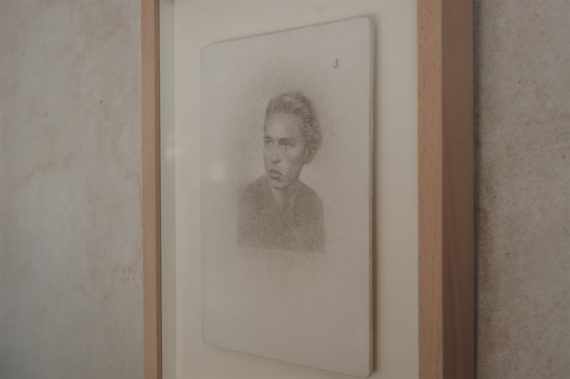“They looked like silver birds. The sun was shining on them…”, silverpoint on gesso on boards, 30cm x 107cm
I’m going to be showing this work in a group exhibition in Margate. I’ve exhibited it before (it was in The Jerwood Drawing Prize 2013 and more recently it was in an exhibition, ‘Remembering We Forget’, at the Sidney Cooper Gallery in Canterbury). I wanted to show it again. Something interesting always happens when work is exhibited. There is no way of predicting who will see it or how they will see it.
The title of the piece is taken from an eye witness memory of the sight of the German Gotha bombers high up in the late afternoon sunlight just moments before one of their bombs exploded amid a shopping queue outside of Stokes’ greengrocers in Tontine Street, Folkestone, on 25th May 1917. Scores of people were killed. This work is about those people who were killed.
The piece is made up of sixty-eight small gesso panels containing silverpoint drawings and hand-written text. Where I have found visual reference for individuals (mostly from a local newspaper published soon after the air raid) I have been able to make drawings of them. Where I haven’t been able to find images I have just written in the space where the face would have been. The faces have been drawn in silver of gesso. I find this medium particularly beautiful to look at (you really have to see the work in reality and close up to appreciate its particular qualities) and it seems to me to be an especially appropriate medium for an artwork about presence and trace (silverpoint lines are delicate things that can’t easily be erased).
It is important to me that these images are hand-drawn. Hand-drawn images are always so much more than the things they refer to. I like to use the word ‘carefulness’ when talking about drawings. Drawings are careful things: they trace the moments of a person’s presence paying attention to something outside of them selves.
I hope people will spend some time looking at the work close up and at various distances. The viewer might begin to notice connections between the various individual panels. The portrait drawings are drawn in subtly different styles depending on the qualities of the original reference material. The texts are written in pencil and these create a different kind of space to the ones created by the drawings of the people’s faces. Together the overall composition creates yet another kind of space. A person reading the writing (hand-writing is a kind of drawing too) might find connections between individuals. People who were together when the bomb exploded have been places near to each other in the artwork.
A person in a gallery chooses to go up to look at a framed drawing and it’s up to them to make up their own minds and I don’t expect anyone else to ‘get’ what I think I’ve put into this work of Art.
The story of how this work came about is a long one but its origins lie in my own family’s memories of the First World War air raids in Margate. One thing leads to another and I became obsessed with the Tontine Street story. I’ve been working on this, in various ways, for a few years and I intend to continue this work as time and money allow. Since making this work I have been contacted by relatives of people who were caught up in the blast and I hope to be able to produce new work to incorporate their memories into future work.
I hope to have time to write more about this piece but for now you can find out more by scrolling down the home page of my wordpress blog (‘Roy Eastland Drawing’) until you find the relevant posts or by going to my facebook page: ‘Roy Eastland’ (https://www.facebook.com/Roy-Eastland-1495390357351370/) and scrolling down to find the relevant posts.
The exhibition is called: ‘MEMORY’. It will be at The Pie Factory in Margate’s ‘old town’ (near Turner Contemporary) and it will be open from ten o’clock in the morning until four o’clock in the afternoon each from Friday 20th to Wednesday 25th. The exhibition has been organised by Kent Creative Live.



